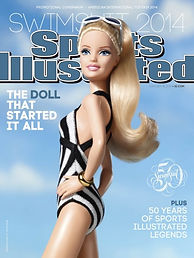
BARBIE AS A SEX SYMBOL
Barbie broke the doll mold when she strutted onto the toy stage in 1959. She was the first adult doll marketed to young girls who previously only had paper and baby dolls as toys. Barbie was a grown woman with full breasts, thin waist and long legs. She became a symbol of the American beauty standard that many women wished to achieve. Unfortunately the ideal body image promoted by Barbie is physically unattainable as her dimensions are not representative of a human body. Barbie’s body has been a topic of much debate and she has been blamed for providing young girls with an unrealistic body image and encouraging eating disorders.
When the doll was introduced in 1959, women were struggling to be beautiful and desirable people, but those ideals shifted slightly with the emergence of the feminist movement in the 1960s. By 1971, the National Organization for Women, one of the largest feminist organizations, had launched a full attack on Mattel and Barbie for sexist advertising. (McDonough, “Barbie”) Everything from Barbie’s proportions to her heavily made up face has been the target of criticism. Barbie’s expression has been described as having a “dumb shine of self-absorption, its trippingly tartish look of one who is out for all she can get...is eerily disturbing” by Pulitzer-prize winning novelist Carol Shields. (McDonough, “Barbie”)
Barbie’s unrealistic proportions have been blamed for leading to poor self image for young girls. According to a study by the University Central Hospital in Helsinki, Finland, Barbie would even lack the amount of body fat required for a woman to menstruate. (McDonough, “Barbie”) Barbie’s feet are also too angled, her waist too small and her breasts too large for her to properly stand if she were a real human. Mattel claims that Barbie’s waist was so thin and breasts so large so that her clothing would fit without becoming too bulky. Unfortunately, Mattel has promoted Barbie’s thin appearance and even suggested that girls shouldn’t eat if they wanted to lose weight. In 1965, Slumber Party Barbie was sold with a book entitled “How to Lose Weight.” (McDonough, “Barbie”)


Worldwide sales of Barbie dolls are down 14% and are expected to continue to drop. (Solomon, 2014) As Barbie’s sales have declined in recent years, Mattel is looking for innovative ways to market Barbie. Most recently Mattel has partnered with Sports Illustrated to promote Barbie as a model in the famous Sports Illustrated: Swimsuit Edition. Mattel collaborated with the famous magazine publisher to compare Barbie to former Sports Illustrated swimsuit models who have gone on to have successful careers. According to Ms. McKnight of Sports Illustrated, “We’re focusing on the legendary women of Sports Illustrated who, like Barbie, launched their careers in a swimsuit.” (Elliott, 2014) Barbie’s first outfit was a swimsuit, so the collaboration was creative and unexpected.
Barbie’s beauty standard is often criticized because adults worry about her effect on children. People wonder if Barbie’s proportions will encourage more children to adopt eating disorders to pursue those desired body goals. Please view the Discovery News video below to gain a better understanding of Barbie’s influence on body image.
Two individuals have become notorious because they wanted to look as much like Barbie and Ken as humanly possible. These individuals underwent dozens of surgeries to look like the plastic dolls. Barbie clearly had an impact on the body image ideals of the individuals below.
